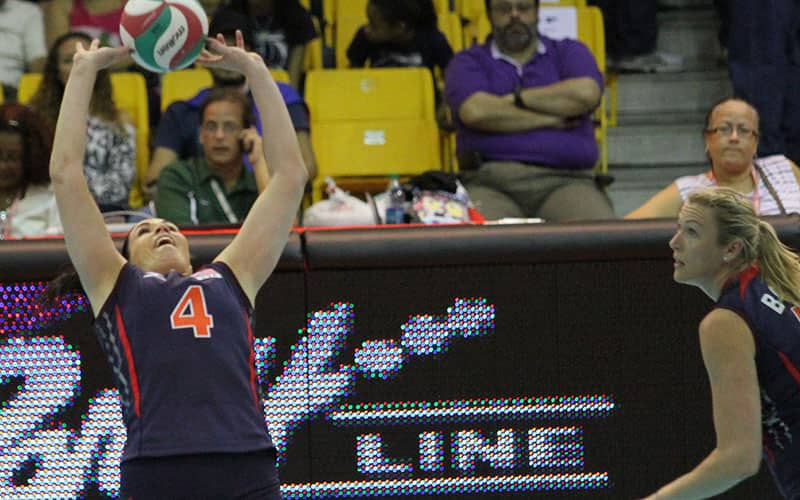
Originally published in the winter 2016-17 edition of VolleyballUSA
Setters
Lindsey Berg (pictured), three-time USA Olympic setter, two-time Olympic silver medalist, captain of the 2012 London Olympic team
If you’re an undersized setter or a setter who doesn’t have all of the desired physical gifts, the most important thing you can do is strive to make your teammates better.
One way to do this is to be very good at ALL the skills – defense, communicating, getting the ball to your hitters in a good spot. Also, focus on being a great leader and a great teammate who sets a good example by always working hard in practice. If you can be an all-around package, you’ll make it easier for those around you to succeed.
Specific to the skill of setting, it’s essential for all setters and particularly undersized setters to understand their hitters’ needs. For instance, the location of an ideal “go” set for one hitter might be quite different than it is for another hitter.
When I was on the USA team, I knew that Jordan Larson liked a faster and slightly lower “go” than Logan Tom. Your job is to give hitters THEIR set, not a one-size-fits-all set.
Outside Hitters
Kevin Maureen Campbell, women’s associate head coach at North Carolina State
If you are an undersized outside hitter, you have to be able to use the peripheral parts of the block.
Developing a high-hands shot and an off-speed shot is important. Also, your skill set has to be better than the big kid with regards to your eye-work. It’s important that you learn how to recognize what defense the other team is running and where they’re coming from when defending shots.
Another key is understanding that the low seam is almost never available. Avoid it! Better options are hitting high hands or tooling out of bounds for the point.
When I was a small outside hitter, I wanted a set wide enough and close enough so I could rip the blocker’s hands. There are very few blockers who can defend a good swipe shot.
I also liked my cross-court options: the deep corner shot from Zone 4 to Zone 4. If you show that all game, then you can go to the line when the defense moves and get your kill.
Middle Blockers
Josh Steinbach, head women’s coach at Villanova
If you’re an undersized middle, you have to have good vision of what the block looks like in front of you. A lot of big middles don’t learn that. They’re just big and physical and hit the way they’re facing. You need to move the ball around, maybe even try a roll shot.
Also, make sure you’re well-spaced from the net. If you get too close, you’ll get underneath the ball, and then you won’t have the ability to see what’s in front of you – both the ball and the block.
As for blocking, always be sure you know where the outside blockers are and how they close. That will help you work well with your teammates on the front line. And understand this: the disadvantages of being 5-11 aren’t as bad as you might think.
Attackers are going to be higher than blockers just because of the way that jump mechanics go. So you’re going to get hit over once in a while. Don’t let it phase you.
Remember, any blocker’s success rate is low. The best blockers are blocking two balls a set, maybe. So smaller blockers have to be relentless and be comfortable with a positive touch. They have to understand what success is for them. It might just be taking the right spaces – say, the ball that’s driven to the middle of the court. Or it might be putting up a block that allows a defender to make a dig. That’s a success for you and your team.
Bonus Tip from Reid Priddy
Outside Hitters
Tod Mattox, head girls varsity coach at Bishop’s High School (San Diego)
Undersized hitters have to be able to shape their attacks. By contacting the ball with a slightly bent elbow and extending it up into the ball, the savvy attacker can hit a ball with curved parabolas rather than straight lines, which leads to a higher success rate.
In addition, attacking when ascending from your jump rather than when you’re descending is critical. If you’re a 6-4 outside hitter, you can hit a ball while you’re on your way down and, chances are, it’ll still go over the net. But the best small attackers hit on their way up. That allows them to tool the block much more easily because the trajectory of the ball is going up rather than down.
The best small attackers that I’ve coached wait a little longer to make their approach. By doing this, they arrive later and time their jump so they’re elevating or are at their peak when they make contact.
Beach Players
Brooke Niles, head beach coach at Florida State University
Smaller beach players can absolutely play at the college level and beyond. Ball control is a factor at any height, especially with the athletes we have now in college and the pros. Always practice the basics of passing and setting.
As a smaller player, though, court vision becomes even more important. Practice your shots but also seeing the defender and blocker.
Small beach players also need to develop a tough serve. Putting opponents in specific positions can help score more points especially when your side out percentage may not be as high as a taller player.
